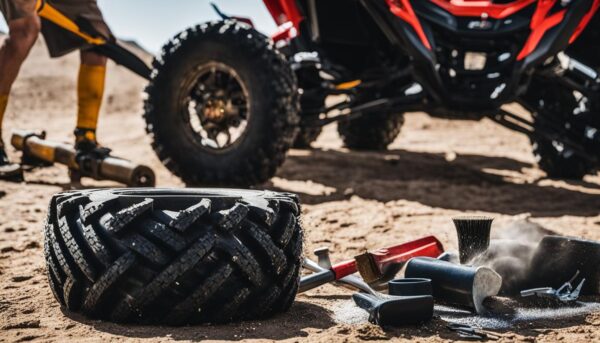Last Updated on 9 months
Keeping Your ATV, Trailer, and Mower Tires in Top Shape During Winter
As temperatures drop and winter settles in, taking care of your ATV, trailer, and mower tires becomes increasingly important. Mid-winter maintenance is essential for prolonging the life and performance of these crucial pieces of equipment. Implementing tire care tips can help you avoid the common issues that winter weather may cause, ensuring your gear remains in top shape for when the warmer months return. This article will discuss helpful tips for maintaining your tires during the colder months.
Key Takeaways
- Monitor and adjust tire pressure to prevent damage from fluctuating winter temperatures.
- Move equipment periodically to prevent flat spots and strain on tires
- Use tire covers or store them indoors to protect tires from harsh winter elements
- Inspect tires for wear and damage regularly, ensuring proper alignment
- Consider using tire chains in icy conditions for improved traction on ATVs
- Maintain proper tire inflation to optimize safety and performance
- Store equipment in dry, relaxed environments to maintain tire health during offseason periods
The Importance of Mid-Winter Tire Maintenance
Mid-winter tire maintenance ensures optimal tire performance and ATV tire safety during the colder months. Cold weather can significantly impact tire pressure, leading to decreased performance or tire failure. Regular tire inspections for wear and damage, keeping tires clean, and ensuring proper alignment of your equipment help maintain the overall health and performance of ATV tires, trailer, and mower tires during winter.
Proper winter tire care goes beyond just monitoring tire pressure: it encompasses protecting and preserving your tires for a longer lifespan. In addition to inspecting and maintaining your tires, using tire chains in icy conditions can enhance traction and help avoid accidents or equipment damage.
Emphasizing the tire maintenance importance, proper tire care can not only avoid premature replacement but also save you money in the long run. Therefore, taking the necessary steps to maintain the health and performance of your ATV, trailer, and mower tires during winter is crucial.
Proper tire care can avoid premature replacement by maintaining the health and performance of ATV Tires, trailer, and mower tires during winter.
- Inspect tires regularly for wear and damage.
- Keep tires clean to prevent slow leaks and other issues.
- Ensure proper alignment to optimize tire performance.
- Maintain equipment, including lubricating moving parts and tightening bolts as needed.
- Consider using tire chains in icy conditions to enhance traction.
By following these guidelines, you can be better prepared for winter and ensure your tires perform optimally throughout the year.
Monitoring Air Pressure in Cold Climates
Temperature plays a significant role in maintaining tire pressure, which is essential for vehicle safety and efficiency. In cold climates, understanding how temperature affects tire pressure and adjusting accordingly is crucial to maximize the performance and lifespan of your tires.
Understanding Tire Pressure Changes with Temperature
During winter, cold temperatures can cause tires to lose air pressure. It’s essential to regularly check and adjust tire pressure according to the vehicle guidelines. Temperature effects on tires can lead to underinflated tires, excessive heat, uneven wear, compromised fuel economy, and tire blowouts.
Tire pressure monitoring is integral to vehicle maintenance during the cold season. Monitoring tire pressure is imperative to ensure your vehicle’s safety and efficiency and prevent premature replacement.
The Golden Rule of Tire Inflation
The golden rule of tire inflation states that tire pressure decreases by one psi for every 10-degree drop in temperature. This guideline helps drivers anticipate how their tire pressure may change as temperatures fluctuate.
Remember: For every 10-degree drop in temperature, tire pressure decreases by 1 psi.
Maintaining tire pressure is crucial to ensure optimal performance during cold weather. Regularly monitoring the pressure and adjusting it according to the recommendation will help prevent issues that arise from underinflation or overinflation.
| Temperature | Tire Pressure Change |
|---|---|
| +10°F | +1 psi |
| 0°F | 0 psi |
| -10°F | -1 psi |
| -20°F | -2 psi |
Always check your tire pressure when the tires are cold, as driving may increase the tire temperature and alter the pressure reading. Be sure to use an accurate tire pressure gauge and refer to your owner for the proper tire pressure for your vehicle.
- Check and adjust tire pressure regularly, especially during marked temperature changes.
- Ensure tire pressure is within the manufacturer’s recommended range.
- Monitor tire pressure when the tires are cold for the most accurate readings.
In conclusion, understanding and applying the golden rule of tire inflation is essential for maintaining tire pressure and your performance and safety in cold weather. Regular monitoring and adjusting tire pressure can help prevent issues caused by temperature fluctuations, ensuring a smooth and safe driving experience.
Maintaining Proper Tire Inflation
Optimal tire performance and safe ATV riding rely on maintaining proper tire inflation. When properly inflated, tires experience reduced premature wear, helping them last longer and perform better. To ensure effective winter tire maintenance, let’s determine the best practices for maintaining the appropriate tire pressure.
One of the easiest ways to maintain proper tire inflation is to regularly check the tire pressure, ideally before each ride, as the pressure may increase after the tires warm up from use. Additionally, maintaining the appropriate tire pressure ensures optimal contact with the road, promoting stability and comfort. To keep tires in the best condition possible, follow these guidelines:
- Refer to the manufacturer’s recommended tire pressure for your specific ATV Tires, trailer, or mower tires.
- Invest in a high-quality tire pressure gauge for accurate readings.
- Check tire pressure before each ride, making necessary adjustments if the pressure is too high or too low.
- Consider using nitrogen instead of air in your tires, as nitrogen is less sensitive to temperature changes.
Remember: Proper tire inflation not only improves performance and safety but also prevents premature wear, saving money and time in the long run.
By following these steps and making tire inflation a regular part of your tire maintenance routine, you can ensure a smoother and safer riding experience while extending the life of your tires. So grab that tire pressure gauge and start checking your tires today!
Repositioning Equipment to Prevent Tire Damage

Repositioning equipment is essential to maintain the longevity and performance of your ATV Tires, trailer, and mower tires during winter. Periodically moving the machinery allows it to rest on different parts of the tire, preventing unnecessary strain and the formation of flat spots.
For storing heavy machinery, lifting the equipment off the ground is recommended. This can be achieved using jack stands, which help prevent bias-ply tires from permanently deforming. This storage strategy optimizes tire longevity and ensures your equipment remains in the best possible condition, ready for use when the winter season ends.
Maintaining the integrity of your tires during seasonal downtime is crucial for preventing tire damage and avoiding costly replacements.
Keep your equipment in optimal condition by repositioning it periodically, reducing the risk of tire damage and extending its lifespan.
Additionally, consider implementing the following tips for effective tire care during the winter months:
- Regularly check tire pressure and adjust as necessary.
- Inspect tires for wear, cracking, or other damages.
- Cover outdoor-stored equipment with tire covers to protect from weather elements.
- Store equipment in insulated environments whenever possible.
| Tire Care Tips | Benefits |
|---|---|
| Repositioning Equipment | Prevents flat spots and uneven wear, extends tire lifespan |
| Checking Tire Pressure | Maintains optimal tire performance and safety |
| Inspecting Tires | Identifies potential issues early, saving money on costly repairs |
| Using Tire Covers | Shields tires from UV rays, oxidation, and harsh weather elements |
| Insulated Storage | Minimizes the impact of cold temperatures on tire integrity |
By incorporating these measures into your winter tire maintenance routine, you can effectively safeguard your equipment against damage and ensure it remains ready for use in the following seasons.
Protecting Your Tires from Winter Elements
Protecting your tires from the elements is crucial as temperatures drop and harsh weather conditions set in. By taking a few precautionary measures, you can extend the life of your tires and prevent unnecessary damage. This section covers the benefits of using tire covers and insulated storage solutions for tire longevity in winter.
Covering Tires to Mitigate Weathering and Cracking
One simple yet effective solution for weather protection for tires is to use tire covers. When equipment is stored outdoors, these covers can shield tires from degrading due to UV rays and oxidation. Additionally, they can help mitigate tire weathering caused by snow, ice, and freezing temperatures.
Utilizing tire covers is a cost-effective way to extend the lifespan of tires by preventing weather-induced wear and tear on your ATV Tires, trailer, or mower tires.
Benefits of Insulated Storage for Tire Longevity
Another important factor contributing to tire longevity is storing your equipment in an insulated environment. Insulated storage shelters or garages can protect your tires from the harmful effects of cold weather, such as temperature fluctuations and moisture. This winter storage solution can help combat oxidation and other damaging effects on your tires.
- Protects tires from freezing temperatures and moisture
- Combats oxidation and premature tire degradation
- Shields tires from harmful UV rays
If storing your equipment in an insulated environment is possible, you can still take precautions by occasionally running the equipment during the winter mo. This helps warm up the tires, which can release the oils in the rubber, contributing to extended tire life.
| Storage Solution | Benefits |
|---|---|
| Tire Covers | Protects from UV rays, oxidation, snow, and ice; extends tire lifespan |
| Insulated Storage | Shields from temperature fluctuations, moisture, and oxidation; promotes tire longevity |
| Running Equipment | Warms up tires, releases oils in rubber, and prolongs tire life |
In summary, protecting your tires from winter elements is vital for maintaining their health and performance. Implementing these measures, such as using tire covers and insulated storage, will surely go a long way in enhancing the life of your tires during the winter months.
Maintenance Tips for Different Types of ATV Tires

Regarding ATV tire maintenance, it’s essential to understand the distinctions between the various types of tires to ensure their longevity and performance. This section focuses on the proper care for ATV mud tires, snow tires, trail tires, and sand tires, along with helpful maintenance tips to promote tire durability.
ATV Mud Tires and Snow Tires Care
ATV mud and snow tires need meticulous maintenance, specifically crafted to provide superior traction and flexibility on various terrains. Given their unique design and compounds, these tires are more prone to uneven wear when inflated incorrectly. The following are some essential tire maintenance tips for ATV mud and snow tires:
- Check and maintain the recommended air pressure regularly.
- Inspect tires for any punctures, cuts, or unusual wear patterns.
- Rotate tires periodically according to the manufacturer’s guidelines.
- Clean the tires, removing any build-up of mud, snow, or debris that can cause damage.
Ensuring the Durability of ATV Trail and Sand Tires
ATV trail and sand tires must also be adequately maintained, keeping them reliable and efficient across different terrains. The following tire maintenance tips can help you enhance the durability of your ATV trail and sand tires:
- Regularly check and adjust air pressure according to the tire manufacturer’s recommendations.
- Carefully inspect the tire tread for wear or damage and address any issues promptly.
- Rotate tires consistently based on the many manufacturers’ delines to promote uniform wear.
Constantly monitoring the conditions of your tires can significantly affect their lifespan and your ATV riding experience!
“An ounce of prevention is worth a pound of cure.” – Benjamin Franklin
In conclusion, correctly maintaining your ATV tires, regardless of their type, is crucial for tire longevity and performance. Following the maintenance tips above, you can enjoy a safe and enjoyable ATV tire riding experience and get the most out of your tires.
Inspection and Upkeep of Trailer Tires
Regular inspection and maintenance of trailer tires are essential for a safe and smooth towing experience. This includes checking tire pressure, ensuring wheel alignment, inspecting for wear or visible damage, and lubricating moving parts such as wheel hubs to minimize friction. Following these essential steps helps ensure reliable towing and enhances the overall performance of your towing vehicle.
Trailer Tire Inspection includes:
- Examining the treads for evidence of uneven wear or damage
- Looking for punctures, cuts, or cracks
- Checking for proper alignment by observing the straightness of wheels when connected to the towing vehicle
When it comes to trailer tire maintenance, practice the following:
- Regularly inflate tires to the manufacturer’s recommended pressure
- Rotate tires periodically to promote even wear
- Lubricate wheel hubs and bearings to reduce friction and minimize wear
Proper maintenance and inspection go a long way in increasing the longevity and functionality of your trailer tires. Investing time and effort in regular review and scheduled maintenance is essential, as they help avoid costly damage and potentially dangerous situations and ensure smooth and reliable towing experiences.
By prioritizing trailer tire inspection and maintenance, you can extend the life of your tires and contribute to safe and reliable towing.
Additionally, create a maintenance schedule and periodically track the performance of your trailer tires. This proactive approach can help identify potential issues early on, allowing for timely corrections and preventing unwanted occurrences during your towing trips.
Advantages of Quality Mower Tires During Winter
Having quality mower tires during winter can result in numerous benefits. As the cold months can be challenging for lawn care and maintenance, it is crucial to have tires that provide better traction and reduce soil compaction. Additionally, using tires designed explicitly for mowers yields a smoother cut and more efficient lawn maintenance.
Regular winter upkeep of your lawn equipment prevents corrosion and maintains performance. This includes cleaning the mower tires, as dirt and debris can accumulate and lead to reduced efficiency. Here are some advantages of having quality mower tires during the winter season:
- Better traction on slippery or frozen surfaces
- Reduced soil compaction, ensuring better lawn health
- Tires specifically designed for mowers result in a smoother cut
- Longer lifespan by using proper winter care and maintenance techniques
As you prepare your lawn equipment for winter storage, implement proper maintenance techniques to ensure your mower tires are ready for use when spring arrives. In doing so, you’ll save on costs related to premature tire replacement and ensure excellent safety and efficiency in your lawn care routine.
Keep your lawn equipment efficient and ready for spring by maintaining quality mower tires throughout the winter months.
You can maintain your lawn equipment’s longevity and overall performance by recognizing the importance of quality mower tires and dedicated winter upkeep. Invest in reliable mower tires to maximize your lawn care experience and keep your yard in pristine condition all year round.
When to Replace Your ATV, Trailer, and Mower Tires
Knowing when to replace your ATV tires, trailer, and mower tires is essential for optimal performance and safety. Tires should be replaced when the tread depth decreases to below 1/8 inch or signs of significant damage, such as cuts or punctures. Additionally, identifying uneven wear patterns or bald spots on tires is crucial for detecting alignment issues or the need for tire replacement.
Spotting the Signs of Tire Wear and Damage
Regular visual inspection of your tires helps detect tire damage and assess whether replacement is necessary. Here are some common signs of tire wear that require prompt attention:
- Tread depth is less than 1/8 inch
- Uneven wear patterns, such as cupping or feathering
- Bald spots, exposing the tiretire’sd
- Cuts, punctures, or visible sidewall damage
- Aging or cracking of rubber—particularly on ATV Tires and trailers that are heavily used or stored outdoors
It’s essential to address these issues immediately to ensure the safety and performance of your ATV Tires, trailer, and mower tires. By regularly inspecting for signs of tire wear and damage, you can help extend the life of your tires and save on costly replacements.
“Regular visual inspection of your tires helps in detecting tire damage and assessing whether replacement is necessary.”
| Tire Type | Expected Lifespan | Replacement Indicators |
|---|---|---|
| ATV Tires | 2-4 years, depending on usage | Tread depth < 1/8 inch, uneven wear patterns, cuts, punctures, bald spots |
| Trailer Tires | 3-6 years, depending on use and storage | Age, tread depth < 1/8 inch, uneven wear patterns, cracks in the sidewall |
| Mower Tires | 4-6 years, depending on service and maintenance | Tread depth < 1/8 inch, irregular wear patterns, bald spots, visible cord |
In conclusion, correctly understanding when to replace your ATV tires, trailer, and mower tires and detecting signs of tire damage can help optimize your equipment’s performance, save money, and ensure safety. Keep an eye on these key indicators, and enjoy a better experience with your ATV Tires, trailer, and mower tires.
Effective Storage Strategies for Offseason Tire Care
As the winter months close, it’s essential to consider proper off-season tire storage techniques to ensure your equipment remains pristine for the warmer months. The following tire care strategies protect your tires from damage and help maintain their integrity and performance for the forthcoming season.
- Elevating Equipment: To prevent flat spots and the risk of tire deformation, elevating your equipment off the ground is a good idea. Whether using jack stands, blocks, or wheel cradles, doing so keeps the tires from remaining static for extended periods and promotes better tire longevity.
- Storing in Dry, Cool Places: Off-season tire storage should occur in a dry and relaxed environment, away from direct sunlight, ex, heat or cold. Basements, garages, or climate-controlled storage units are ideal locations for winter gear storage.
- Using Tire Covers: Tire covers create a barrier that protects your tires from the elements, oxidation, and UV rays. Ensure all tires are clean and free from moisture before covering them.
To help visualize these effective storage strategies, the table below summarizes optimal off-season tire care methods and their benefits.
| Storage Strategy | Benefits |
|---|---|
| Elevating Equipment | Prevents flat spots and tire deformation by distributing weight evenly |
| Storing in Dry, Cool Places | Protects tires from extreme temperatures, dampness, and sunlight |
| Using Tire Covers | Shields tires from oxidation, UV rays, and other elements that could cause degradation. |
Proper offseason tire storage not only protects your tires from potential damage but also helps maintain their integrity and performance for the forthcoming season.
In conclusion, utilizing adequate off-season tire storage and care strategies is essential for maintaining the longevity and performance of your ATV Tires, trailer, and mower tires. By elevating your equipment, storing tires in dry, excellent environments, and using protective covers, you help ensure your tires are ready to use as soon as the warmer weather arrives.
Conclusion
Maintaining proper tire care during winter ensures longevity and prepares equipment for optimal use in the coming season. A comprehensive winter tire maintenance summary involves monitoring air pressure, inspecting for damage, and adhering to proper tire care practices.
Protecting your tires from harsh winter elements and storing them correctly can significantly impact their lifespan, allowing you to make the most of your investment. Staying proactive in your tire care practices ensures safety and optimal performance during winter and beyond.
By following these guidelines, you can be confident that your ATV Tires, trailer, and mower tires will be in peak condition and ready for use in the spring. Ultimately, taking these simple yet effective measures can save you time and money and provide peace of mind as you venture out with your equipment, regardless of the season.
FAQ
What is the importance of mid-winter tire maintenance?
Mid-winter tire maintenance is critical for optimal performance and safety. Cold weather can significantly impact tire pressure, leading to decreased performance or tire failure. Inspecting tires for wear and damage, keeping them clean, and ensuring proper alignment is also essential. Good tire care can avoid premature replacement and maintain the health and performance of ATV Tires, trailers, and mower tires during winter.
How does temperature affect tire pressure?
In cold climates, tire pressure decreases by one psi with every 10-degree drop in temperature. Underinflation can lead to excessive heat generation, uneven wear, compromised fuel economy, and safety hazards like tire blowouts. Maintaining proper tire pressure according to the manufacturer’s recommendation is crucial.
How can I prevent tire damage when storing equipment during winter?
Equipment should be periodically moved to rest on different parts of the tire to prevent unnecessary strain and flat spots on tires. Lifting the equipment off the ground using jack stands for heavy machinery can prevent bias-ply tires from permanently deforming and optimize tire longevity.
What are some ways to protect tires from winter elements?
Tire covers can protect tires from degrading due to UV rays and oxidation when equipment is stored outdoors. Utilizing tire covers is a simple yet effective method to extend the lifespan of tires by preventing weather-induced wear and tear. Keeping equipment in insulated environments can combat oxidation and other harmful effects of cold weather on tires.
How should I maintain different types of ATV tires during winter?
ATV mud and snow tires require careful maintenance, particularly regarding air pressure and visual inspections for damage or unusual wear patterns. For ATV Tires and sand tires, regular maintenance includes checking for the correct air pressure, inspecting the tread for wear, and ensuring the tires are free from cuts or punctures.
What are some tips for inspecting and maintaining trailer tires?
Regular inspection and maintenance of trailer tires are essential for safe and smooth towing experiences. This includes checking tire pressure, ensuring wheel alignment, inspecting for wear or visible damage, and lubricating moving parts such as wheel hubs to minimize friction.
How can quality mower tires be advantageous during winter?
The benefits of having quality mower tires during winter include better traction and reduced soil compaction. Clean the tires regularly to prevent corrosion and maintain performance. Using tires explicitly designed for mowers results in a smoother cut and better lawn care.
When should I replace my ATV, trailer, and mower tires?
Replacement of ATV tires should be considered when the tread depth decreases to below 1/8 inch or signs of significant damage, such as cuts or punctures, manifest. Identifying uneven wear patterns or bald spots on tires indicates alignment issues or replacement needs.
What are some effective storage strategies for off-season tire care?
Effective storage strategies for tires during the offseason include elevating equipment to prevent flat spots and storing it in dry, cool places to protect it from temperature fluctuations. Such practices help maintain the integrity of the tires and prepare them for use in the spring.













 Français
Français Español
Español